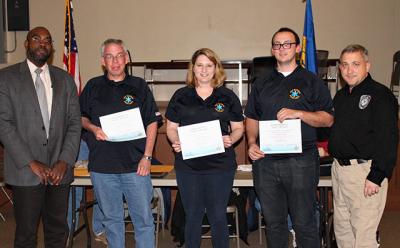E.M.T.s Awarded for Saving Two Lives

Emergency medical service personnel were recognized last week for saving the lives of two people in recent months. Members of the Sag Harbor Volunteer Ambulance Corps saved a woman who had choked on food and had lost consciousness in October, and the East Hampton Village Ambulance Association saved the life of a man experiencing a complicated cardiac problem last month.
The Suffolk County Regional Emergency Medical Services Council honors personnel when a patient is revived after cardiopulmonary resuscitation and walks out of the hospital. In both cases, the patients were not only breathing on their own, but they were up and speaking to their rescuers before they arrived at the hospital.
An all-volunteer crew from Sag Harbor made up of several veteran providers sprang into action when they received a report of a woman choking at Baron’s Cove restaurant on the night of Oct. 16. Eddie Downes, a longtime emergency medical technician and the former president of the ambulance corps, drove the agency’s first-responder vehicle to the restaurant, arriving within minutes. He was directed to a hallway between the dining room and kitchen, where he found people trying to perform the Heimlich maneuver on a woman in her 70s.
“She was almost unconscious,” Mr. Downes said. “She couldn’t even get her hands to do this,” he said, making the universal sign for choking.
As he tried the Heimlich on her himself, Mr. Downes yelled to Mike Stone, an E.M.T., to call for advanced life support. Denise Schoen, a volunteer certified in A.L.S., arrived practically right away, Mr. Downes said. The woman then went completely unconscious. She was not breathing and had no pulse.
They laid her flat on her back, and Mr. Downes started chest compressions while Ms. Schoen tried to open her mouth. Her jaw was locked, Ms. Schoen said. Mr. Downes’s compressions helped force a large piece of duck, about two inches long and cylindrically shaped, out of the woman’s throat.
“She went from blue to pink right away,” Ms. Schoen said. Soon she was sitting up and engaged in conversation as though nothing had happened. “It was incredible.”
The volunteers found out that the woman has Parkinson’s disease, which has affected her gag reflex, and that she has choked before, though not as severely.
There is no doubt, Ms. Schoen said, that the woman would have died. “If Ed didn’t do the compressions he did at the right depth and speed, he wouldn’t be able to force that piece of meat back up the trachea because it was so big,” she said.
Suffolk REMSCO awarded Ms. Schoen, Mr. Downes, Mr. Stone, and two fellow E.M.T.s, Amber Pagano and Pete Hopping, certificates and pins to mark the save at a meeting of Suffolk REMSCO on Jan. 12.
An East Hampton crew was recognized for a save on the afternoon of Dec. 15, after a 911 call about a man who had passed out. Owen Cooke, a paramedic working as part of the paid provider program started in 2014 to supplement the volunteer organization, responded and found a man in his early 50s who had regained consciousness.
Randy Hoffman, a critical-care technician who volunteers with the ambulance association, was nearby and responded when Mr. Owen called for additional assistance. With the patient hooked up to a portable cardiac monitor, the paramedic could see he was experiencing a life-threatening irregular heartbeat, called ventricular tachycardia.
“You rarely see them because you usually don’t get there in time,” Mr. Hoffman said, adding that in his nine years in E.M.S. he has seen such a case only once.
The man’s blood pressure was plummeting, and his heart was beating at more than 285 beats per minute (60 to 100 is normal). While his heart was trying to compensate, not enough blood was being pumped through his body. At that point, “Cardiac arrest is imminent,” Mr. Hoffman said.
Mr. Hoffman quickly realized the gravity of the situation and warned Paul Mangano, an emergency medical technician, and Pat Ryan, who was behind the wheel of the ambulance, that they had to move the patient ever so carefully because a sudden movement or bump could throw the heart into a non-life-sustaining rhythm.
Once in the ambulance, Mr. Owen and Mr. Hoffman readied the man for a procedure called cardioversion, in which an electrical shock is used, even though the patient is conscious, to return an abnormally fast heart rate to a normal rhythm. The hope, Mr. Hoffman said, is that the shock stops the fast heartbeat so it can reset itself.
The patient, however, lost a pulse altogether, so the crew began doing CPR and shocked him again, but this time with more than three times as much energy as before. He regained a pulse. At Southampton Hospital, where a team was readying to transport him to Stony Brook University Hospital for more extensive treatment, he was sitting up and talking, according to Mr. Hoffman.
“We were lucky. Everybody was lucky that day,” he said.
